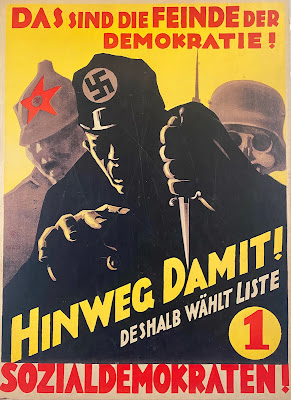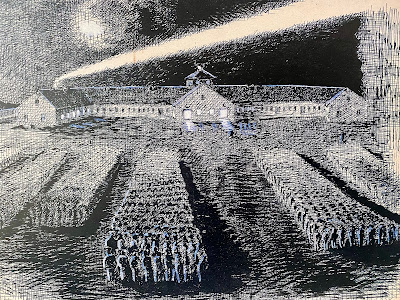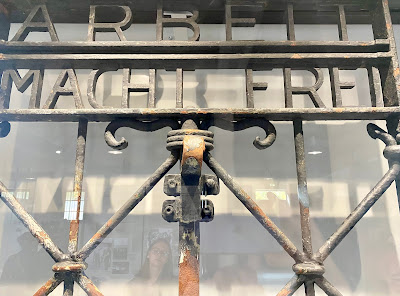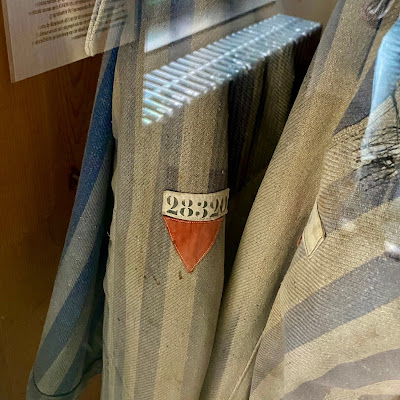While Dachau lacked the emotional punches I experienced at Buchenwald, my first visit to a German concentration camp, and again at Theresienstadt, it certainly expanded my visceral knowledge of the Holocaust, which younger non-Jewish generations seem to have forgotten.
When the National Socialists were elected to form a government in 1933, Hitler came to power with 44% of the vote (Trump lost the 2020 U.S. Presidential election with 47% of the vote if you're thinking of backing a third-party candidate next year). Five years earlier, Social Democrats had known what was up.
 |
| "These Are the Enemies of Democracy" |
So had the German Democrats, but they and other parties--including the Communists--split the vote in '33, a tumultuous period in German history after the collapse of the Weimar Republic.
 |
| "Clean Up The Reich" |
In 1936, the SS also forced prisoners to forge a cynical "welcome sign" inscribed with the now infamous phrase "work will set you free" that was placed on the gate at the entrance to the camp. In 2014, thieves stole the sign. An anonymous tip led to its recovery in Norway three years later. The original sign, encased in a plastic box, is now secured inside the exhibit hall.
Dachau never functioned as a death camp although as many as 40,000 lives ended there due to overwork, torture, starvation, medical experimentation and disease.
But it did serve as the primary model for the extermination factories that the Nazis built elsewhere under the tutelage of this SS monster.
 |
| Theodor Eicke, Camp Commandant (1933-1939) |
 |
| Drawing by Karel Frinta, Czech Prisoner (1941) |
 |
| Corporal Punishment Drawing by Albert Kerner (1938) |
 |
| Punishment Bench & Switch |
Pole hanging was another common form of punishment. Prisoners were handcuffed from behind and then hung from a hook for two hours at a time. Here are the remains of a hook anchor embedded in the wall.
The Nazis also subjected prisoners to inhumane high altitude and hypothermia to better protect Luftwaffe pilots who were likely to be exposed to these conditions during battle.
 |
| Hypothermia Experiment Drawing by Georg Tauber (1945) |
This monster, a respected tropical diseases specialist before the war, wasn't even a Nazi but his medical "research" at Dachau included exposing more than a thousand prisoners to malaria-carrying mosquitos and keeping careful records of their symptoms. Hundreds died.
 |
| Professor Dr. Claus Schilling |
 |
| Mosquito Cage & Prisoner Medical Records |
The experiments were conducted in this building near the camp's perimeter. Imagine the screams. And the pain. And the fear.
Prisoners who tried to escape were shot from watch towers like these, separated from the inmate population by a moat.
Schilling didn't show any remorse when American camp liberators tried him in 1945. He even asked if he could continue the experiments in the name of science.
After the war, the camp remained in use as housing for displaced Germans until 1960. Five years later, the site finally became a memorial but only one of the camp's 32 barracks remains standing.
Prisoner drawings of roll call, which could last as long as three hours no matter the weather conditions, give visitors a sense of the crowding when the camp was functioning at peak capacity.
 |
| Drawing by Karl Freund (1938) |
 |
| Drawing by Ferdinand Dupuis (1944-45) |
The SS kept meticulous records, registering each new arrival.
Patches on their blue-striped uniforms enabled guards to identify the kind of prisoner by sight. They also included the number tattooed on their wrists.
Prisoners who fell into more than one category wore multiple patches and were treated even more harshly.
German-language books could be borrowed from the camp library by prisoners without yellow stars.
According to a brief documentary film shown to visitors, Dachau didn't formally acknowledge the victimization of homosexuals until 1984, when a small ceremony took place outside the Protestant church on the memorial site. In fact, an early sculpture commemorating the camp's victims didn't include a pink triangle although it appears that some now have been added.
An exhibit also now explicitly acknowledges homosexuals as a separate category.
Leopold Obermeyer (1892-1943) was a Jewish wine dealer and Swiss citizen who would have worn both a yellow star and a pink triangle.
Obermeyer described his treatment by the SS at Dachau on September 16, 1935, the day he found out his mother had died:
"Lang [the SS guard] ordered "Cell 10", his special "specialist", to run next to me, push me forward and kick me, which "10" did as best he could, he also punched me in the kidneys until he had kicked me down. Then I had to go to Lang's room, he took a stick out of the cupboard and threatened me with 25 lashes next time. Then I had to go, hot and with my pulse racing, under the ice-cold shower, dressed until I was dripping wet from my shirt to my shoes. Then went back into the yard - it was quite cool - and marched on. I was then chained by Lang in the presence of Kantschuster [Lang's SS superior], in dripping wet clothes, with my hands, head down, to the floor ring in cell 10. Sitting down with threats is forbidden. My body formed a semicircle! I was freezing miserably and the mistreatment had made me extremely sick. Totally exhausted. At 11 o'clock Kantschuster and Lang came, waving a dispatch. Lang shouted: "One more Jew less, your mother is dead." Only after repeated requests was I unchained, I was not given dry clothes and had to wrap myself naked in a blanket . So perhaps my life was saved by my mother; I could have stayed like that [chained] overnight. Writing materials refused despite death.”
Families of other Jewish victims have provided heartbreaking photographs of dead relatives prior to their confinement. They remind visitors how political regimes can completely change the lives of individuals.
Faith--or perhaps denial--sustained a Polish chaplain, one of Dachau's many religious prisoners, who designed this incongruous advertising poster for an herb garden. It looks as if could have been used as Nazi propaganda.
The lurid cover of this survivor memoir better captures the reality.
Other survivors created physical memorials, like the iron swastika at the top of the page, and this marble triangle. According to Google, the heading translates "KNOWN TO DEATH,
KEPT QUIET."
The crematoria are nearby. Prior to the war, prisoner death rates were low enough that only two ovens were needed to burn remains. Several more were added, along with a gas chamber that was used only for instructional purposes.
The area where the Nazis disposed of prisoners' ashes is now sacred ground.
On the same day that I learned a terrorist attack in Israel had killed more Jews than on any day since the Holocaust, this multi-lingual memorial left me wondering if we can be so certain.
More Bavaria:































No comments:
Post a Comment